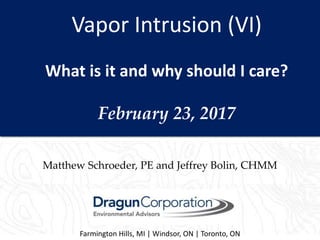February 2017 Vapor Intrusion Update Oakland County Bar Association
- 1. Vapor Intrusion (VI) What is it and why should I care? February 23, 2017 Farmington Hills, MI | Windsor, ON | Toronto, ON Matthew Schroeder, PE and Jeffrey Bolin, CHMM
- 2. What is Vapor Intrusion? Vapor Intrusion (VI) Conceptual Site Model
- 3. Why Should We Care? Text ’éĘ 10 years ago VI was not typically evaluated in RIs ’éĘ Now VI concerns are often a driver for investigations and remediations ’éĘ Included in ASTM Phase I standard ’éĘ Recently added to Superfund scoring*
- 4. Why Should We Care?
- 5. Why Should We Care? My site is closed! ŌĆó We all heard MDEQ say ŌĆ£A deal is a dealŌĆØ butŌĆ”
- 6. Why Should We Care? VI is regulated differently depending on location, and the guidance is changing rapidly ŌĆó USEPA guidance (2015) ŌĆó State guidance (Michigan, Ohio, Indiana, and Illinois all revised/issued guidance within the last year) ŌĆó California, Massachusetts incorporating new science quickly (maybe before proven?)
- 7. Why Should We Care? VI is regulated differently depending on location, and the guidance is changing rapidly ŌĆó Inconsistency across jurisdictions on what data is needed and what criteria apply ŌĆó Very conservative assumptions used to calculate screening levels ŌĆó Difficult to off-ramp once you exceed a screening level Soil and groundwater? Sub-slab vapor? Indoor air? Models? Attenuation factors? OSHA criteria? Criteria
- 8. MichiganŌĆÖs Draft Rules (VI) ŌĆó Issued in June 2016, revised in October 2016 ŌĆó Tiered approach to VI assessments ŌĆó Tier 1 ŌĆō Initial Screening Levels ŌĆó Tier 2 ŌĆō Generic Criteria (incorporate soil type, depth to groundwater) ŌĆó Tier 3A ŌĆō Generic Criteria (Use Facility-Specific Land Use & Building Specifications) ŌĆó Tier 3B ŌĆō Site Specific Data ŌĆó Vapor Intrusion Calculator Tool (under development) ŌĆó Generally tries to avoid Indoor Air Testing
- 9. MichiganŌĆÖs Draft Rules (VI) Note ŌĆ£FacilityŌĆØ Designation Conceptual Site Model
- 10. The Perfect Storm TCE and Vapor Intrusion ŌĆó TCE short-term exposure limits ŌĆó Reliability of science doesnŌĆÖt seem to matter ŌĆó Response actions required within days ŌĆó Michigan using Department of Health and Human Services to circumvent process and force evacuations until response actions conducted Image from NBC
- 11. How do I determine if VI is an issue at my site? ŌĆó Soil and groundwater data ŌĆó Subsurface soil gas ŌĆó Sub-slab soil gas ŌĆó Indoor air
- 12. WhatŌĆÖs on the horizon (or closer)? ŌĆó Overcoming sampling variability ŌĆó Passive, long duration indoor air sampling ŌĆó Large volume sub-slab sampling ŌĆó Isotope analyses to differentiate sources ŌĆó Handheld GC to identify sources to indoor air
- 13. Takeaways ŌĆó Vapor intrusion assessment is changing rapidly, in the science, regulations, and public awareness ŌĆó More so than ever before, vapor intrusion is the driver for remediation/mitigation actions ŌĆó Vapor intrusion concerns can kill deals, cause evacuations, and lead to litigation liability
- 14. Questions?
Editor's Notes
- #3: EPA: ŌĆ£Vapor intrusion is the general term given to migration of hazardous vapors from any subsurface vapor source, such as contaminated soil or groundwater, through the soil and into an overlying building or structure.ŌĆØ Fuels (benzene, in particular) Solvents (TCE, TCA, CT) Dry cleaning chemicals (PCE and its breakdown products) Landfill gas (methane)
- #4: If VI was evaluated, it was done using soil and groundwater data Relatively high screening levels A few high profile incidents where VI became a widespread issue despite gw concentrations ŌĆ£passingŌĆØ Much higher awareness of VI considerations among regulators (varying levels of technical understanding) Potential for third party litigation (class action) Discuss Storage Mart project ŌĆō did not consider CVOCs in due diligence, seven figure remediation driven by VI concerns (owner going after consultant) *Trump administration put this on hold until further review is completed
- #5: Public awareness (VI in the news) Last one ŌĆō right in our own backyard
- #6: If the Superfund scoring change passes, many sites could get added to the Superfund list Some States (MA, MN, NY) reopening closed sites Michigan ŌĆō 4,000 orphaned sites with potential VI issues According to MDEQ, no plans to reopen ŌĆ£privateŌĆØ closed sites Will sites reopen due to VI concerns during transactions or refinancing?
- #7: USEPA guidance ŌĆō long time coming State guidance ŌĆō each one is different
- #8: With each guidance revision, screening levels seem to go down Dense sampling networks and multiple sampling events needed to off-ramp
- #9: Higher level of data collection needed for higher tiers of assessment Rules still in draft, but you should consider them when assessing sites (since MDEQ will be)
- #10: Focus on CSM ŌĆō can off ramp from there Facility designation ŌĆō implications on transactions, due care obligations
- #11: We stole the slide title from an article by David Gillay of B&T 3 things coming together ŌĆō focus on VI, new tox information on TCE, aggressive actions by regulatory agencies USEPA Region 9 began enforcing mitigation actions based on potential short-term exposure to first-trimester pregnant women Based on a single 22-day study on female rats that has not been successfully replicated Reference DHHS memo re GR sites
- #12: Summa canister ŌĆō traditionally 24 hours, new thinking ŌĆō IA = 8-10 hours (work shift), SS = 200 mL/min (30 min for 6L canister) Why not just collect IA samples? Data interferences with IA sampling Some criteria near background (TCE, benzene) Paired IA + SS samples TO-17 (sorbent tubes) ŌĆō captures both VOCs and SVOCs, less sampling time, 1/3 rental cost, not yet widely accepted (not included in USEPA or MI guidance, although MI accepting on case by case basis)
- #13: All these techniques are available, but not widely used Research indicates indoor air concentrations are variable temporally, sub-slab vapor concentrations are variable spatially













